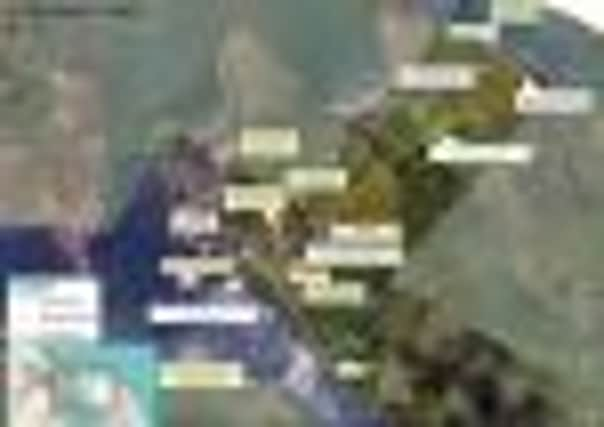363 objections to Islandmagee gas storage proposal


Planners, who received 363 letters of objection to the Islandmagee Storage Ltd (IMSL) proposal to excavate caverns in salt layers 1,500 metres (4,900 ft) under Larne Lough, acceded to a request from Larne Borough Council to defer issuing a final decision for one month.
The local authority wants to arrange an office meeting at which the cases for and against the project can be further considered.
Advertisement
Hide AdAdvertisement
Hide AdHowever, the recently formed lobby group Marine Conservation NI is to ask the council to facilitate a public meeting. MCNI chairman Nigel Hamilton added that they will also press the council to take a lead in opposing the gas storage plan and fight it “to the end”.


IMSL’s application, submitted in March, 2010, is for facilities on the ground - between Ballylumford power station and the Moyle Interconnector - including a leaching plant, sea water pumping station and a well pad to accommodate a drilling rig for seven boreholes.
The Larne Times understands the majority of objections concern environmental issues and in particular IMSL’s intention to pump brine from the excavated caverns through a pipeline 450 metres out to sea. Nigel Hamilton has claimed the millions of litres of brine will have a “devastating” effect on marine and bird life. He described the proposal by Planning Service to approve the planning application as “a disgrace”
The former Newtownabbey councillor said the brine would “pollute and poison the marine subculture in the area”, adding: “It will be effectively like a lunar landscape”.
Advertisement
Hide AdAdvertisement
Hide Ad“It will kill off sea weed and drive away shellfish, drive away fish and drive away birds which are supposed to be in a place of sanctuary,” he claimed, while urging Larne Council to “give a lead to constituents who are determined to fight this application to the end”.
Asked why the brine cannot be disposed of further out to sea, the IMSL has said that a longer outfall would require construction to take place by open-trenching methods “which would cause greater impacts to the seabed during construction and might cause a permanent obstruction to certain types of fishing vessel”.
The company’s website (www.islandmageestorage.com) adds : “Detailed 3-D hydrodynamic dispersion modelling has taken place to verify that the tidal currents at this location are capable of dispersing the brine at all stages of the tide and that pools of brine will not accumulate on the sea bed.”
On the impact of brine on marine life, IMSL said the brine - a by-product of dissolving salt in sea water to form the seven storage caverns - has a natural tendency to sink to the sea bed if incorrectly discharged. “In order to prevent this from happening, a specially designed diffuser will be fitted to the end of the outfall to force discharged brine upwards through the water, thus causing it to be diluted and dispersed rapidly,” the company added.
Advertisement
Hide AdAdvertisement
Hide AdIMSL, which submitted environmental impact studies in support of its planning application, set out its assessment of the impact on marine life:
“The area within 10 metres of the outfall discharge point is expected to experience significant increases in salinity, which is likely to cause a significant decrease in the diversity and abundance of species inhabiting the sea bed within this area. However, mobile species will be able to avoid this area and fish will be able to pass through this zone with no ill effects.
“The area between 10 and 100 metres from the outfall discharge point, the ‘mixing zone’, will experience levels of salinity slightly in excess of what would be expected to occur naturally. This may cause a decrease in species abundance and diversity within this zone, although the effects will reduce with increasing distance from the discharge point. Nonetheless, many species which are more tolerant to changes in salinity will be able to continue inhabiting this zone.
“Beyond 100 metres from the outfall discharge point, increases in salinity above background levels will be very small. It is not anticipated that there will be any detectable adverse impacts to species living within this zone.”
Advertisement
Hide AdAdvertisement
Hide AdIMSL also said the brine outfall would “cease operations” after the caverns have been constructed, and claimed: “The small area of impacted seabed will be able to begin re-colonisation and recovery within days of stopping the discharge, as there will be no residual contamination.”
Should planning permission be granted for the project, a subsequent licence will be required from the Northern Ireland Environment Agency to discharge brine into the sea. IMSL said: “The agency would monitor the dispersion of the brine in the marine environment continuously throughout the process of creating the caverns. The process would be stopped immediately if, at any time, salt concentrations reached a trigger level which would be agreed beforehand with the Environment Agency.”
IMSL’s data appears to indicate that the planned facility could have a storage volume of up to 500 million cubic metres (18 billion cubic feet) of natural gas which could be pumped through the interconnector throughout Ireland, the United Kingdom and Europe.
“The asset would have a significant positive impact on the dynamics of the gas market in the whole of Ireland and add to the security of gas supplies in Northern Ireland. Indeed, in winter Northern Ireland could become an exporter of gas from its current position of 100 per cent dependence on import,” according to IMSL.
Advertisement
Hide AdAdvertisement
Hide AdIslandmagee Storage Project is a joint venture between InfraStrata plc and Mutual Energy Ltd.
In January this year, the companies entered into agreements with BP Gas Marketing Ltd (BPGM) regarding the appraisal of the project, and the grant of an option to BPGM to acquire a 50.495 per cent equity interest.